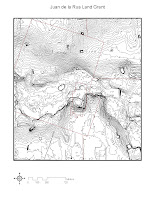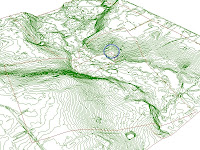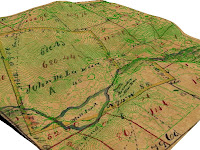
Several of our first test units are now complete, so we are opening up additional trenches in pursuit of more architectural features. One frequently asked question is "When do we stop digging?" Archaeologists usually stop at the "subsoil," a stratum that predates human occupation of a site. After excavation, the walls and floor of completed test units are cleaned with trowels one last time, photographed, and mapped (In that order.) Since archaeology is a destructive discipline, it is important to document every observable physical characteristic of the exposed stratigraphy before back-filling each unit. While it may seem odd that we will be filling them in so soon at the end of the season, it helps protect the surrounding proveniences from erosion during the rest of the year.

Our mapping procedures require the use of a level line and a couple of rulers. Instead of measuring down from a surface that can vary from unit to unit, or even within the same unit, we align our rulers perpendicular to the suspended string and use that as the point to measure from. Thanks to this work, our better knowledge of the stratigraphy of Area A is permitting some of our new units to dig in strata rather than arbitrary levels.

I mentioned earlier that digging in 10cm levels is a popular choice, especially in prehistoric sites and sites for which the stratigraphy is unknown. However, now that we have a better idea of the site's stratigraphy, digging in strata has some tempting advantages. Saving time is an obvious first point; since the archaeologist is only looking for when the soil color or composition changes to stop and start a provenience, he or she doesn't have to constantly pause excavation to take elevation measurements to make sure that they aren't digging too deep.

Digging in strata on a site like Arcadia also helps give each provenience a single separate stratum as opposed to having a single provenience include multiple strata. If you're confused, the adjoining image should help explain. This delicious-looking layer cake to the right has an arrangement of "strata" composed of alternating layers of cake and frosting. Let's say we only wanted to eat the cake parts and save the frosting for a friend. If we didn't have any idea of what the cake looked like on the inside, we would be forced to arbitrarily "excavate" (eat) layers until we found the parts of the cake that we want to "separate into proveniences" (his frosting, our cake.) However, if you knew that this particular cake had six evenly-spaced layers of cake and frosting, you would have a much better idea of when to stop eating the cake and skim the frosting off with your fork. To complete this illustration before it makes me any hungrier, the best way to figure all of that out is to cut the cake vertically so that all of the layers are visible. That way you don't have to risk eating any frosting at all (why you would ever want to do something like that is not part of the illustration.)
It's time to talk a little about some of the artifacts that we've been recovering. Our field season this year has been fortunate to find a considerable number of artifacts associated with people's activities.

This iron is remarkably well-preserved. We suspect that one of the artifacts that we've previously excavated and identified as a drawer handle might actually be the handle to this iron. The lab will be on the lookout for a potential cross-mend.

From left to right, we have a burned peach pit, a fragment of a toy marble, a couple of gun flints, a couple of percussion caps, and a possibly decorative metal ring. Personal items like the ring, the marble, and the peach pit give unique insight into the habits of people living in the past by hinting at the sorts of things they ate and how they chose to spend their free time. Since all of these artifacts come from an early 19th century sheet midden, the gun parts suggest that the individuals living at the village were armed.

 The field school has reached its half-way point, with our scope of Area A expanding to four blocks and five trenches with a combined total of over 75 test units. The search for architectural remains continues, and we are adding some crushed brick piers to our map that line up well with known geophysical anomalies and the results of our predictive models.
The field school has reached its half-way point, with our scope of Area A expanding to four blocks and five trenches with a combined total of over 75 test units. The search for architectural remains continues, and we are adding some crushed brick piers to our map that line up well with known geophysical anomalies and the results of our predictive models. We are interested in carrying our excavations to the south and east next, so we had our first geophysical survey of the summer in the freshly cleared area. Soil Resistivity has been an effective tool at Arcadia in past years, and Sarah Mitchell came down to show our students how to operate the device.
We are interested in carrying our excavations to the south and east next, so we had our first geophysical survey of the summer in the freshly cleared area. Soil Resistivity has been an effective tool at Arcadia in past years, and Sarah Mitchell came down to show our students how to operate the device. The soil resistivity meter reads electrical impulses sent from a pair of metal spikes stuck in the ground several meters away. The current travels through the ground to be measured by the machine that the operator walks with and sticks in the ground at prescribed points. High resistivity in one area can mean a number of different things, such as compacted or artifact-laden soil. If present, foundations can also be detectable as well.
The soil resistivity meter reads electrical impulses sent from a pair of metal spikes stuck in the ground several meters away. The current travels through the ground to be measured by the machine that the operator walks with and sticks in the ground at prescribed points. High resistivity in one area can mean a number of different things, such as compacted or artifact-laden soil. If present, foundations can also be detectable as well. In addition, our field school has begun its maritime component. We now have some of our crew in Pond Creek every day mapping the shape of the channel and the structural remains of pilings, rocks, and beams that have lain there since Arcadia was abandoned. UWF was able to get some underwater video of the mill foundation beams in the early 1990's, but this recon survey will give us a more complete
In addition, our field school has begun its maritime component. We now have some of our crew in Pond Creek every day mapping the shape of the channel and the structural remains of pilings, rocks, and beams that have lain there since Arcadia was abandoned. UWF was able to get some underwater video of the mill foundation beams in the early 1990's, but this recon survey will give us a more complete idea of how these structures are situated and how well they are withstanding erosion. In addition, part of understanding community organization at Arcadia comes from knowing where roads used to be, so one of the other goals of the underwater survey is to find bridge-related features that would help us locate any roads that crossed Pond Creek.
idea of how these structures are situated and how well they are withstanding erosion. In addition, part of understanding community organization at Arcadia comes from knowing where roads used to be, so one of the other goals of the underwater survey is to find bridge-related features that would help us locate any roads that crossed Pond Creek.















